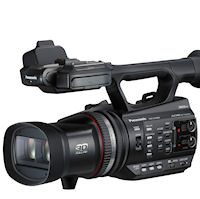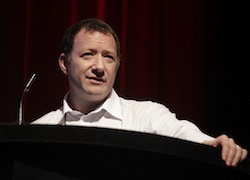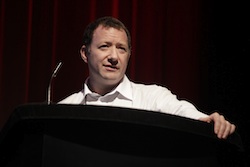
By the end of the year over 20 dedicated 3D channels will have launched worldwide, with another 30 broadcasters planning or completed major 3D trials. Adrian Pennington provides a status report on European 3D rollout and where the business goes from here.
The 3DTV bandwagon shows no signs of slowing down, but crunch time could come in a year when broadcasters will review just how well the consumer experience has gone down. “If we do bad 3D then this will fail but if we do good 3D it will become something incredible and set the stage for where we want to get to which is glasses free,” says Sky Director of Product Development, Brian Lenz (pictured). “That could be ten years away and right now we have to prove demand and prove the concept.”
Screen Digest has identified 21 dedicated channels already launched or planned for 2010, 13 of which are in Europe. These include the Sky DTH family of BSkyB, Sky Italia and Sky Deutchland which launched simultaneously carrying the Ryder Cup golf and dedicated cable broadcasts in Finland, Estonia and the Czech Republic. Add in major trials and planned commercial launches worldwide and the figure tops 50.
Around half of the launches are for a permanent standalone channel or segments within pre-existing channels rather than one-off events, with most channel plans including sports content. Most one-off event activity this year was aligned with the French Open Tennis and FIFA World Cup and it could be the London Games 2012 when the next round of major launch activity takes place.
Pay-TV operators are driving the charge, using a frame compatible format that allows existing HD set-top boxes to receive a 3D signal from existing HD infrastructure. However this still requires customers to purchase a 3D-ready set and while manufacturers are planning to retail more product with 3D as standard, by 2014 in the UK just 10% of all installed TV sets will be 3D-capable with France and Germany around 8% (according to Screen Digest).
As HD gathers mainstream momentum pay-TV operators spy in 3D a new premium format with which to differentiate themselves in the market — but gaining a return on the investment in additional bandwidth and production costs will be a long term project.
According to Screen Digest senior TV analyst Tom Morrod 3D is an expensive addition to a pay-tv operator’s bouquet: It’s going to be difficult for most pay TV operators, even the largest established ones, to justify the costs of 3D production. Only customers who pay for Sky’s top-tier subscription package and have Sky+ HD set-top boxes, paying approximately £60 per month, will get Sky 3D free of charge.
“It’s an upsell, a retention benefit, a market differentiator, a premium content proposition,” says Lenz. “All those things turn into monetisation opportunities for us. 3D doesn’t have to be a standalone price point for us to derive direct financial benefit.”
Whereas the SD to HD transition could be readily made by down-converting the HD signal to cover SD and HD reception, originating a 3D signal requires another set of cameras, another production workflow, another uplink which, says Screen Digest TV Analyst Tom Morrod, “doubles and in some cases more than doubles the HD bandwidth and costs.”
A simulcast of a 2D and a 3D broadcast is not remotely close to the right way to go with 3D, agrees Lenz. “This is especially true for live sport which requires two totally different production and editorial processes.
“When you have the luxury in post to craft the image and generate a 2D cut from the 3D, then same time production is fine and I don’t feel I am sacrificing either way. But I don’t believe 2D and 3D simulcast on the same signal is ever a good idea — even if that means a separate 3D production is more expensive.”
The FTA conundrum
Futuresource Consulting confirm that no DTT operators have launched or are as yet even trialling 3D in Europe. Although most free to air (FTA) broadcasters, BBC included, have voiced interest in 3D programming, with penetration of 3DTV sets remaining low in the short term there’s no clear economic rationale or market demand for FTA broadcasters to rush to launch 3D services.
Moreover, now that the first flush of one-events has passed, operators are declaring difficulty in sourcing 3D content without entering into original production. Studios and content owners are also placing a higher premium on 3D programming. BSkyB recognised this and is funding a substantial portfolio of original 3D production to complement its movies and sports package, but few other operators have the pockets to follow suit.
“The lack of true 3D content in the marketplace has created a sellers’ environment and on occasion has resulted in broadcasters being expected to pay unrealistic premiums for content, particularly when they themselves are currently unable to charge the customers a premium,” says Futuresource Research Consultant David Watkins.
Between 30% to 50% premium, audience size dependent, has been cited as realistic for a broadcaster to pay for quality 3D content. “To help fill the 3D content gap at a lower cost, many broadcasters, particularly in Asia, have sought out high quality short-form content as a cheaper alternative,” says Watkins.
The cost of content is likely to dip as the market for 3D develops. By 2014 for example 40% of all digital cinema screens in the UK (1,285) will be 3D and in France (1,534) and Spain (901) the percentage tops 45% of digital installed screens over the same period (Screen Digest). Producers could tap into the growing market (currently 10% of all 3D cinema box office receipts) for live event and alternative content screenings in movie theatres.
Also driving 3D to the home will be the computer games market and packaged media. Futuresource predicts 30m 3D Blu-Ray players will enter the European market in 2014; that’s 93% of total Blu-Ray shipments.
As 3DTV rolls out there remain some significant barriers. There’s market uncertainty, content availability and question marks over consumer interest and willingness to pay.
Even Sky’s Lenz is forced to admit that the jury is hung. “3DTV will not be for everyone. We are confident that 3D will be a huge success but we need to be careful. It’s not just up to us but to technology partners, content suppliers and CE manufacturers to make this work. Right now we are all in a fortunate position because the destiny of 3D is in the industry’s hands.”
3D activity in select European markets
Germany: Sky Deutchland’s 3D service launched with the Ryder Cup last month covering a potential one million Sky HD box owners in Germany and Austria. Key 3D sport events will include UEFA Champions League, DFB-Cup, German Ice Hockey League, and when the DFL offers 3D production, the Bundesliga. The service launched on satellite, and through the KBW cable service. Since September Deutsche Telecom’s IPTV service Entertain has begun offering on-demand 3D movies, sports and documentaries.
UK: Sky 3D launched October 1 including Premiership football, documentary 3D Flying Monsters, sections of content from National Geographic and movies like Monsters vs Aliens and Alice In Wonderland in the run-up to Christmas. Discovery Communications has a UK 3D license and is likely to launch on Sky’s platform next year. Virgin has launched a 3D package on its FilmFlex on demand service including BBC Films’ StreetDance 3D and animation Despicable Me 3D. The BBC has conducted trials of natural history, live sport and other genre and has signalled plans to capture elements of the 2012 London Games in 3D.
France: Public broadcaster France Télévisions produced some 3D coverage of the French Open in May and commercial rival TF1 offered 3D coverage of several World Cup matches. IPTV operator Orange launched its 3D service on the back of the Roland Garros tournament in May and airs a limited amount of sports, special events and factual programming. Canal+ aired select 3D World Cup matches, and plans a full-scale channel launch before year-end. Broadband operators SFR and Free also carry TF1 and Canal+ 3D programming. The country’s largest cable operator Numéricable launched a 3D demo channel, in cooperation with Panasonic, ahead of a VoD launch later this year.
Spain: Canal+ Spain, branded Canal+ en 3D, demoed a concert in 3D in April and also aired select matches of the summer’s world cup in the format. Transmissions are carried on Digital+, the Sogecable-owned satellite pay-TV operator, to subscribers with iPlus boxes.
Italy: Sky Italia launched a dedicated 3D sport channel coinciding with the Ryder Cup in October. Pay-TV rival Mediaset has a premium on-demand 3D service featuring The Legend of Beowulf and Journey to the Centre of the Earth 3D among 50 TV/film titles. Public broadcaster RAI has conducted 3D tests and is providing 3D programming for SES Astra’s pan-European 3D channel.
The Netherlands: Cable company Ziggo is to carry Net 5 3D, a new channel owned by SBS. The plan is to upgrade Net 5′s regular programming to 3D, while during the night native 3D programming will be scheduled. Ziggo previously aired a political debate in 3D. Fellow Dutch cable operator UPC transmitted the US Masters Golf in 3D, played out by Netherlands-based provider Digital Media Centre.







